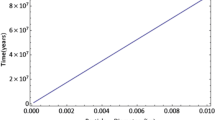Abstract
The aim of this paper is to provide an analytical tool, which might improve models in which the particle-in-a-box approach has been applied and that may be also used when the thin disk approximation could not be longer appropriate. The dispersion velocity is the root-mean-square planetesimal, asteroid, or Kuiper belt object velocity with respect to the local mean circular orbit. This velocity is a function of the object orbital eccentricity and inclination. We calculate a general expression of the dispersion velocity for the planar case in which the object’s orbit has no inclination with respect to the local mean circular orbit and for the spatial case in which it has an inclined orbit. Our general expression of the square of the dispersion velocity may be expanded around any value of e for the planar and spatial cases, being in space an exact solution of the orbital inclination i. We expanded our expression around \(e=0\) with \(i=e/2\) to study solid accretion rates and collision probabilities. We find that in the whole range of eccentricities and inclinations, our results are lower than solid accretion rates and collision probabilities computed by using the expressions of the dispersion velocity usually adopted in the literature. We apply our expressions of the square of the dispersion velocity expanded around e=0 and up to sixth order in e in our numerical model of planetary formation with planetesimal fragmentation and in our model of the collisional frequency on large asteroids. Our formalism, although generally giving lower values than previous approximations, validates the formerly used estimates for the applications presented here. In addition, we calculate the statistical velocity dispersion obtaining a straightforward expression as a function of the eccentricity.















Similar content being viewed by others
References
Adachi, I., Hayashi, C., Nakazawa, K.: The gas drag effect on the elliptical motion of a solid body in the primordial solar nebula. Progress Theoret. Phys. 56, 1756–1771 (1976). https://doi.org/10.1143/PTP.56.1756
Beitz, E., Blum, J., Parisi, M.G., Trigo-Rodriguez, J.: The collisional evolution of undifferentiated asteroids and the formation of chondritic meteoroids. Ap. J. 824(1), 12 (2016). https://doi.org/10.3847/0004-637X/824/1/12
Beitz, E., Güttler, C., Nakamura, A.M., Tsuchiyama, A., Blum, J.: Experiments on the consolidation of chondrites and the formation of dense rims around chondrules. Icarus 225(1), 558–569 (2013). https://doi.org/10.1016/j.icarus.2013.04.028
Binney, J., Tremaine, S.: Galactic dynamics (1987)
Bottke, W.F., Durda, D.D., Nesvorný, D., Jedicke, R., Morbidelli, A., Vokrouhlický, D., Levison, H.: The fossilized size distribution of the main asteroid belt. Icarus 175, 111–140 (2005). https://doi.org/10.1016/j.icarus.2004.10.026
Chamberlin, A.B.: JPL’s Asteroid and Comet Database - Custom Web-based Tools. In: AAS/Division for Planetary Sciences Meeting Abstracts #40, Bulletin of the American Astronomical Society, vol. 40, p. 435 (2008)
Chambers, J.: A semi-analytic model for oligarchic growth. Icarus 180(2), 496–513 (2006). https://doi.org/10.1016/j.icarus.2005.10.017
Chambers, J.E.: Giant planet formation with pebble accretion. Icarus 233, 83–100 (2014). https://doi.org/10.1016/j.icarus.2014.01.036
Czechowski, Z., Leliwa-Kopystyński, J., Teisseyre, R.: Rise of planetary bodies. In: R. Teisseyre, J. Leliwa-Kopystyński, B. Lang (eds.) Evolution of the Earth and Other Planetary Bodies: Physics and Evolution of the Earth’s Interior 5, pp. 51–187 (1992)
Danby, J.M.A.: Fundamentals of celestial mechanics (1992)
Gomes, R., Levison, H.F., Tsiganis, K., Morbidelli, A.: Origin of the cataclysmic Late Heavy Bombardment period of the terrestrial planets. Nature 435(7041), 466–469 (2005). https://doi.org/10.1038/nature03676
Greenberg, R., Bottke, W.F., Carusi, A., Valsecchi, G.B.: Planetary accretion rates—analytical derivation. Icarus 94, 98–111 (1991). https://doi.org/10.1016/0019-1035(91)90143-H
Greenzweig, Y., Lissauer, J.J.: Accretion rates of protoplanets. Icarus 87, 40–77 (1990). https://doi.org/10.1016/0019-1035(90)90021-Z
Grishin, E., Perets, H.B.: Application of gas dynamical friction for planetesimals. I. Evolution of single planetesimals. Apj 811(1), 54 (2015). https://doi.org/10.1088/0004-637X/811/1/54
Guilera, O.M., Brunini, A., Benvenuto, O.G.: Consequences of the simultaneous formation of giant planets by the core accretion mechanism. Astron. Astrophys. 521, A50 (2010). https://doi.org/10.1051/0004-6361/201014365
Guilera, O.M., de Elía, G.C., Brunini, A., Santamaría, P.J.: Planetesimal fragmentation and giant planet formation. Astron. Astrophys. 565, A96 (2014). https://doi.org/10.1051/0004-6361/201322061
Guilera, O.M., Fortier, A., Brunini, A., Benvenuto, O.G.: Simultaneous formation of solar system giant planets. Astron. Astrophys. 532, A142 (2011). https://doi.org/10.1051/0004-6361/201015731
Ida, S., Guillot, T., Morbidelli, A.: Accretion and destruction of planetesimals in turbulent disks. Astrophys. J. 686, 1292–1301 (2008). https://doi.org/10.1086/591903
Ida, S., Makino, J.: Scattering of planetesimals by a protoplanet: slowing down of runaway growth. Icarus 106(1), 210–227 (1993). https://doi.org/10.1006/icar.1993.1167
Inaba, S., Tanaka, H., Nakazawa, K., Wetherill, G.W., Kokubo, E.: High-accuracy statistical simulation of planetary accretion: II. Comparison with N-body simulation. Icarus 149, 235–250 (2001). https://doi.org/10.1006/icar.2000.6533
Jutzi, M., Michel, P., Benz, W., Richardson, D.C.: Fragment properties at the catastrophic disruption threshold: the effect of the parent body’s internal structure. Icarus 207(1), 54–65 (2010). https://doi.org/10.1016/j.icarus.2009.11.016
Kaula, W.M.: An introduction to planetary physics - The terrestrial planets (1968)
Levison, H.F., Bottke, W.F., Gounelle, M., Morbidelli, A., Nesvorný, D., Tsiganis, K.: Contamination of the asteroid belt by primordial trans-Neptunian objects. Nature 460(7253), 364–366 (2009). https://doi.org/10.1038/nature08094
Lissauer, J.J., Stewart, G.R.: Growth of planets from planetesimals. In: E.H. Levy, J.I. Lunine (eds.) Protostars and Planets III, pp. 1061–1088 (1993)
Morbidelli, A., Bottke W. F., J., Froeschlé, C., Michel, P.: Origin and Evolution of Near-Earth Objects. In: Asteroids III, pp. 409–422 (2002)
Morbidelli, A., Bottke, W.F., Nesvorný, D., Levison, H.F.: Asteroids were born big. Icarus 204, 558–573 (2009). https://doi.org/10.1016/j.icarus.2009.07.011
Murray, C.D., Dermott, S.F.: Solar system dynamics (1999)
Parisi, M.G.: Impact disruption of primordial planetesimals. Planet. Space Sci. 75, 96–104 (2013). https://doi.org/10.1016/j.pss.2012.09.013
Parisi, M.G., Beitz, E., Blum, J.: Compaction, cratering and collision frequency on chondritic parent objects. Boletin de la Asociacion Argentina de Astronomia La Plata Argentina 58, 313–315 (2016)
Ronco, M.P., de Elía, G.C.: Formation of Solar system analogues - II. Post-gas-phase growthand water accretion in extended discs via N-body simulations. MNRAS 479(4), 5362–5384 (2018). https://doi.org/10.1093/mnras/sty1773
Safronov, V.S.: Evolution of the protoplanetary cloud and formation of the earth and planets. (1972)
San Sebastián, I.L., Guilera, O.M., Parisi, M.G.: Planetesimal fragmentation and giant planet formation. II. Dependencies with planetesimal relative velocities and compositions. Astron. Astrophys. 625, A138 (2019). https://doi.org/10.1051/0004-6361/201834168
Stern, S.A.: On the collisional environment, accretion time scales, and architecture of the massive, primordial Kuiper belt. AJ 112, 1203 (1996). https://doi.org/10.1086/118091
Stern, S.A.: Signatures of collisions in the Kuiper disk. Astron. Astrophys. 310, 999–1010 (1996)
Stern, S.A., Colwell, J.E.: Accretion in the Edgeworth-Kuiper belt: forming 100–1000 KM radius bodies at 30 AU and beyond. Astron. J. 114, 841 (1997). https://doi.org/10.1086/118518
Tsiganis, K., Gomes, R., Morbidelli, A., Levison, H.F.: Origin of the orbital architecture of the giant planets of the Solar System. Nature 435(7041), 459–461 (2005). https://doi.org/10.1038/nature03539
Weidenschilling, S.J.: Initial sizes of planetesimals and accretion of the asteroids. Icarus 214, 671–684 (2011). https://doi.org/10.1016/j.icarus.2011.05.024
Wetherill, G.W., Stewart, G.R.: Formation of planetary embryos—effects of fragmentation, low relative velocity, and independent variation of eccentricity and inclination. Icarus 106, 190 (1993). https://doi.org/10.1006/icar.1993.1166
Acknowledgements
This work was supported by PIDT 11/G172 grant from Universidad Nacional de La Plata, Argentina. MGP thanks A. Morbidelli for useful comments on collision probabilities. We are very grateful with the referees who have helped us to greatly improve this paper. OMG and ILSS are partially OMG and ILSS are partially supported by the PICT 2018-0934 from ANPCyT, Argentina. OMG also acknowledges the financial support from the Iniciativa Científica Milenio (ICM) via the Núcleo Milenio de Formación Planetaria (NPF) Grant, Chile.
Author information
Authors and Affiliations
Corresponding author
Additional information
Publisher's Note
Springer Nature remains neutral with regard to jurisdictional claims in published maps and institutional affiliations.
Appendices
Jacobi integral
1.1 Planar case
In the frame of the restricted three-body problem (Danby 1992; Kaula 1968) for orbital inclination \(i=0^{o}\), the square of the relative velocity \(v^{2}_{2Saf}\) in the protoplanet rotational system is given by Safronov (1972):
We average Eq. (59) over one orbital period as:
Then,
where
Substituting Eqs. (62) and (17) in Eq. (61), we arrive to Eq.(18), i.e., \(\langle v^{2}_{2Saf}\rangle \)=\(v^{2}_{DP}\).
1.2 Spatial case
In a reference system rotating with the protoplanet around the star, the squared relative velocity \(v_{3Saf}^2\) of a planetesimal with an eccentric, inclined orbit with respect to the circular orbit of the protoplanet (Danby 1992; Kaula 1968) at the point of intersection of the orbits is given by
If \(i=0^{o}\), Eq. (63) equals Eq. (59), i.e., \(v_{D3Saf}^2 = v_{D2Saf}^2\). Averaging Eq. (63) over one orbital period
and substituting Eq. (62) in the second term and Eq. (17) in the third term of the right hand of Eq. (64), we arrive to Eq. (25), i.e., \(\langle v^{2}_{3Saf} \rangle =v_{DS}^2\). Note that when \(i=0^{o}\), \(v_{DS}^2 = v_{DP}^2=\langle v^{2}_{2Saf}\rangle =\langle v^{2}_{3Saf} \rangle \).
Planar case plus the average over a vertical oscillation
The epicyclic approximation (Binney and Tremaine 1987) describes the motion of a particle in the meridional plane, where the particle motion is given by a simple harmonic oscillation in the XY plane plus a simple harmonic oscillation in the vertical direction. In a similar way, for (e, i) \(<<\) 1, the square of the standard dispersion velocity in space \(v^{2}_{3sdt}\) (the square of Eq. (33), Lissauer and Stewart (1993)) may be obtained as the first term of Eq. (19) plus the contribution of the average over a vertical oscillation.
From Fig.1, the vertical component of the planetesimal position measured with respect to the XY plane is
Then, deriving Eq. (65)
Substituting Eqs. (7) and (8), in Eq. (66) we obtain
Substituting Eq. (9) in Eq. (67), rising to the square and averaging in the way shown in Eq. (13), we get
Finally, developing Eq. (68) in power series around \((e=0,i=0)\), approximating \(\sin {i}\) \(\sim \) i, adding the first term of Eq. (19) and keeping terms up to second order in (e,i), we arrive to the square of Eq. (33).
Rights and permissions
Springer Nature or its licensor (e.g. a society or other partner) holds exclusive rights to this article under a publishing agreement with the author(s) or other rightsholder(s); author self-archiving of the accepted manuscript version of this article is solely governed by the terms of such publishing agreement and applicable law.
About this article
Cite this article
San Sebastián, I.L., Parisi, M.G., Guilera, O.M. et al. Dispersion velocity revisited. Celest Mech Dyn Astron 135, 11 (2023). https://doi.org/10.1007/s10569-023-10128-5
Received:
Revised:
Accepted:
Published:
DOI: https://doi.org/10.1007/s10569-023-10128-5




